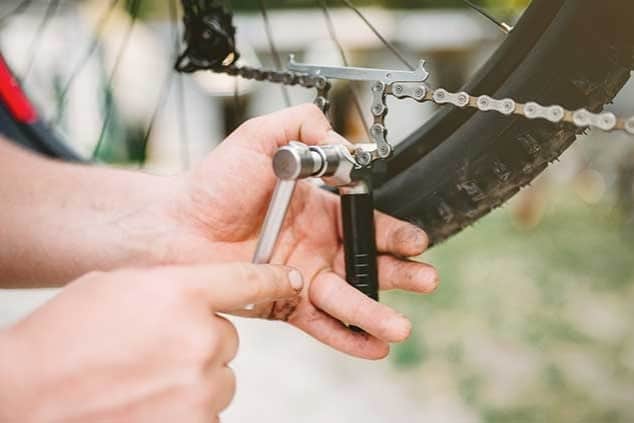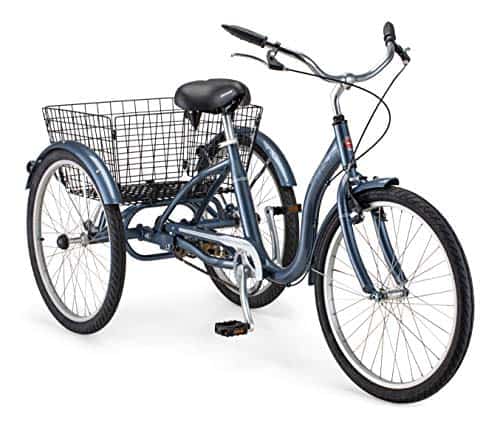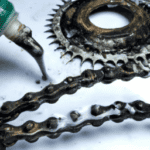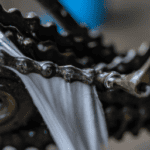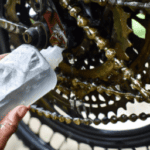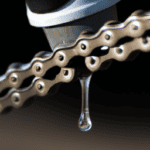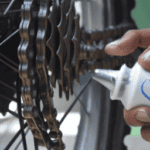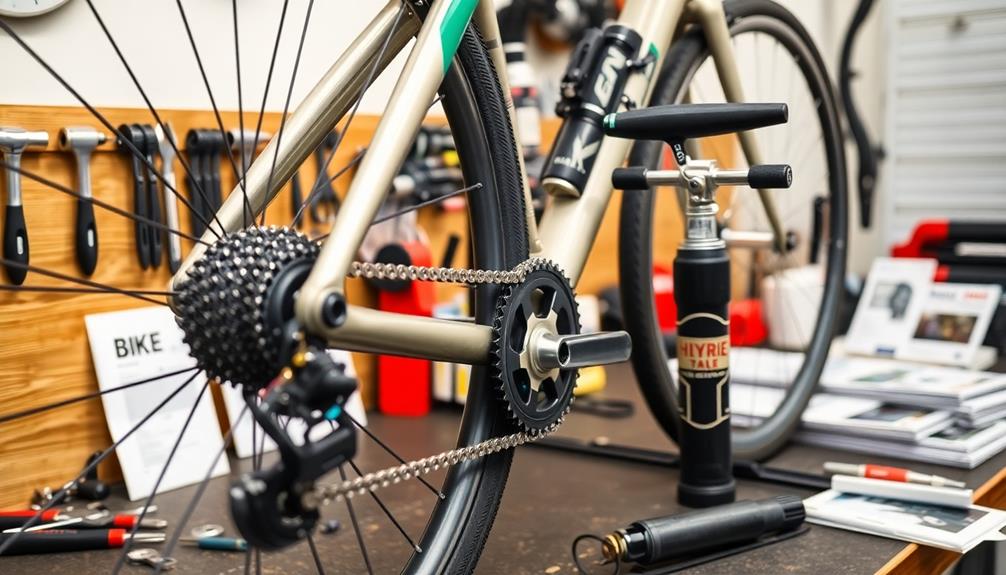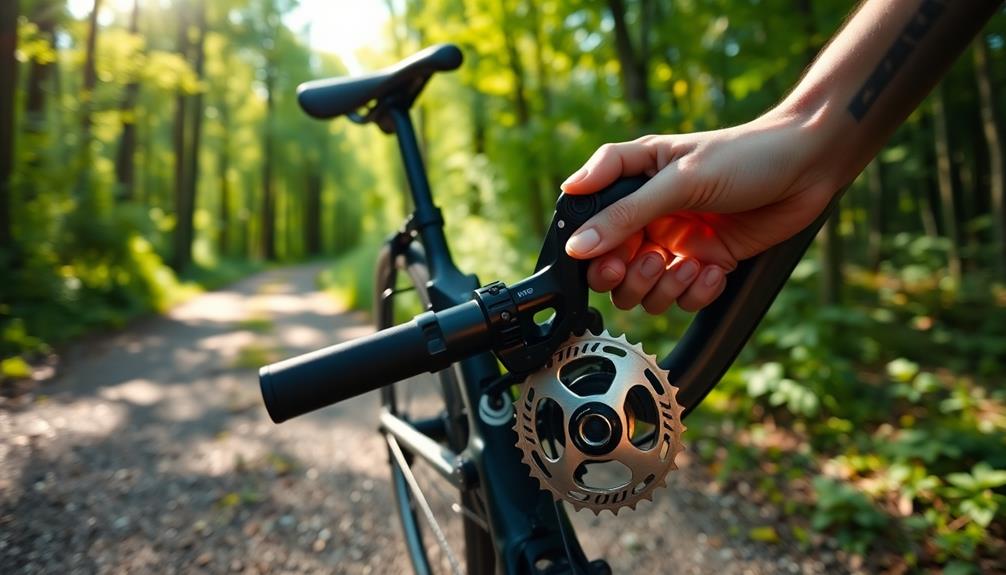Hello, cycling aficionados! You’re in the perfect spot if you’re seeking advice on cleaning your bike chain.
Keeping your bike chain clean is essential for keeping your ride in tip-top shape and making sure that it runs smoothly.
I’m a bicycle maintenance technician and I know all the best practices for cleaning a bike chain.
In this article, I’m going to give you step-by-step instructions on how to get the job done right.
So let’s get started!
Overview Of Bike Chain Maintenance
Maintaining your bike chain is an essential part of keeping your bicycle in tip-top shape. A clean and lubricated chain helps to ensure that you can enjoy smooth, efficient pedaling. It also prevents the unnecessary wear and tear that results from a dirty or dry drivetrain.
To get started, you’ll need some basic supplies: a chain lube, a chain cleaner, and a lubricant.
When it comes to cleaning and lubricating your bike chain, it’s important to do so after every ride. This will help keep all of your components running smoothly as well as prevent dirt and grime from building up over time.
Start by removing any excess dirt or debris that may be present on the chain, then use the chain cleaner to remove all traces of gunk from both the inside and outside of the links. Once everything is clean, apply a thin coat of lube to each link of the chain, making sure not to miss any spots.
After applying the lube, give it some time to penetrate into the links before wiping off any excess with a rag. Taking proper care of your bike’s drivetrain will ensure that you can enjoy smooth riding for years to come – no matter what terrain you choose to explore!
With these steps in mind, you’re now ready to start preparing for cleaning your drivetrain.
Preparing To Clean The Drivetrain
Getting your bike’s drivetrain ready for cleaning is the first step. To do this, you’ll need to remove the chain and use a chain keeper or other device to keep it from moving around on its own.
You’ll also want to get some degreaser or other cleaning product that is specifically designed for bicycle chains.
Next, you’ll want to take some time to inspect the chain and make sure that it doesn’t have any dirt or grime trapped in between the links that could get stuck in there during the cleaning process. If necessary, use a brush or cloth to try and remove as much of this debris as possible before beginning.
Once everything is prepped and ready, it’s time to start cleaning your bike chain. Do this by applying the degreaser or cleaner directly onto the chain itself, making sure that all of the components are thoroughly coated.
Allow it to sit for several minutes before rinsing off with warm water and drying with a soft cloth.
With your drivetrain prepared, you’re now ready to move on to actually cleaning your bicycle chain.
How To Clean A Bicycle Chain
Now that you’ve got the bike ready for its cleaning session, it’s time to focus on the drivetrain. The chain is the most important part of your bike and needs to be properly taken care of. Cleaning your chain will help keep your bike in good shape and running smoothly.
I’ll show you how to clean a bicycle chain.
First, take out a degreaser or cleaner and apply it to the chain using a rag or an old toothbrush. Take some time to scrub all around the chainring, cogs, and cassette area. This will help remove any built-up dirt or debris from those hard-to-reach areas.
Next, use a brush and lube to lubricate your chain. You want to make sure that you get every link of the chain because this is what helps reduce friction between parts and makes for smooth gear shifting. Don’t forget to get inside both sides of each link as well!
After you finish lubricating the chain, it’s time to move onto rinsing and drying it off.
Rinse And Dry The Chain
The bicycle chain is like a river coursing through the mountains and valleys of your bike, carrying the wheels along on their journey. It’s vital to keep that river clean and flowing by regularly rinsing and drying the chain.
To begin, rinse the chain in clean water to remove as much dirt and debris as possible.
Once it’s been rinsed, use a clean rag to dry off any excess moisture. Allow the chain to dry completely before proceeding further.

To make sure you get all the water out from between each link, use a cloth or brush to wipe off any excess moisture.
Now that your bike’s chain is sparkling clean and dry, you’re ready for the next step – applying lubricant to protect it against corrosion and wear.
Applying Lubricant To The Chain
Now that you’ve rinsed and dried your chain, it’s time to apply lubricant. Knowing what kind of lube to use can be tricky, so let’s break it down.
A wet lube is recommended for wet or rainy climates, as they are oil-based and provide better protection from rust and corrosion. Dry lubes are better for dry weather conditions; they’re wax-based and won’t attract dirt like wet lubes do.
Now that you know the differences between the two types of lube, let’s get started.
Before you start lubing your chain, make sure it’s clean by wiping off any excess residue with a rag or brush. This will ensure the chain is free from dirt and grime before you apply any lubricant.
Once the chain is clean and dry, spread some drops of lube along each link of the chain. Spin the pedals a few times to work the lubricant into all parts of the chain, then wipe off any excess using a cloth or rag.
Now that you know how to clean and lube your bike chain, you’ll be able to keep your bike running smoothly and efficiently! With just a few simple steps (and some elbow grease), your chain will stay in tip-top shape for years to come!
How To Lube A Bicycle Chain
Similar to a car needing oil, your drivetrain also needs regular lube to keep it running smoothly. Think of it as a lubricant that keeps the chainsaw of your bike functioning properly.
Imagine if you were to neglect your chain – it would become like an old rusty saw blade, losing its sharpness and eventually becoming completely useless.
When selecting the lube you use, choose one specifically designed for bicycle chains. This type of lube is usually made up of a combination of oils and waxes and will help protect against dirt and moisture buildup. Also make sure that the lubricant you use does not leave a sticky residue on the chain or other parts of the drivetrain, as this can attract even more dirt and grime over time.
It is important to remember that no matter how much lube you put in, if your chain is dirty then it won’t be able to do its job properly – so cleanliness is key! To keep your drivetrain functioning efficiently, make sure to periodically:
- Clean off any dirt or debris with a cloth or brush
- Apply lubricate evenly along the entire length of the chain
- Wipe off any excess lubricant that’s left behind on the outside of the chain
- Inspect the chain for any signs of wear or damage and replace if necessary.
Keeping The Chain Clean
Now that your bike chain is well lubricated and running smoothly, it’s important to keep it clean. Grease and dirt can accumulate on the chain over time, which can cause a lot of wear to the parts of your drivetrain. Cleaning your bike chain only takes a few minutes, but it pays off in the long run by helping you get smoother rides and longer-lasting parts.

The first step to cleaning your bike chain is to un-attach it from your bike. This will make it easier to access the link pins so you can remove them for a deep clean.
Once removed, put a rag around the chain so you don’t get lube or dirt on yourself or anything else. Dip the chain into some warm water with dish soap added in and use an old toothbrush to scrub away any grimy build-up that has accumulated over time.
Rinse off the suds with fresh water and then let it air dry while you finish up other tasks.
Once dry, take some drip lube and lightly apply it to each link as needed – just enough for a light slick coating of protection between each pin link. Make sure every piece of your bike chain is well-lubricated for smooth running performance and always be sure store any unused lube in a cool place after use – this helps keep it fresh for future use!
Doing these steps regularly will ensure you have a fresh chain that runs smoothly during every ride!
What Is A Drivetrain?
As a bicycle maintenance technician, I often get asked what a drivetrain is. In simplest terms, the drivetrain includes all of the components that help power your bike. This includes the chain, crankset, pedals, cassette and derailleur. All of these parts work together to help you pedal and move forward on your bike.
When it comes to maintaining your drivetrain and keeping it in good working order, one of the most important things to do is keep your bike chain clean and lubricated. A dirty bike chain can not only be inefficient but also cause premature wear on other components such as the rear cassette and derailleur.
Cleaning and lubricating your bike chain regularly will help ensure optimal performance and extend its life span. It’s relatively simple to clean a bike chain – all you need is some degreaser, an old rag or brush and some lube. Start by shifting into the smallest gear in the rear so the chain is tight and then spray degreaser onto any surface grime on the chain links. Use a brush or rag to scrub away any dirt particles before rinsing off with water. Once dry, apply lube generously to each link of the chain as this helps reduce friction between them when pedaling.
Now that we understand what a drivetrain is and how to clean a bike chain using it’s time to look at some of the benefits of cleaning and lubricating your bike chain regularly…
Benefits Of Cleaning And Lubricating Your Bike Chain
Cleaning and lubricating your bike chain is an important part of maintaining your bike. Whether you’re a recreational cyclist, daily commuter or serious biker, your chain needs regular attention to keep it running smoothly.
Here I’ll explain the benefits of keeping your chain clean and lubed:
- Keeping your chain clean prevents dirt from grinding away at the metal components, preventing wear and tear.
- Lubrication reduces friction between the moving parts, reducing energy loss and making shifting gears easier.
- A freshly lubed chain makes for smooth pedaling and increased efficiency, allowing you to go further with less effort!
When it comes to bike maintenance, a clean and lubricated chain is essential for optimal performance. Regular cleaning and lubrication not only keeps dirt at bay but also helps to keep your chain in top condition, ensuring an enjoyable ride every time!
Different Types Of Chain Lube
When it comes to maintaining your bike chain, you’ll need a few key items. First up is a bike lube; this will help keep the chain running smoothly and reduce wear and tear.
You’ll also want to grab a chain scrubber and degreaser; this will help get rid of any dirt or grime that’s built up on your chain. Finally, you might want to consider using drip lube or waxed chains for extra protection.
Using the right lube is essential when it comes to maintaining your bike chain. A good quality lube will help keep your chain functioning efficiently, while also providing protection against dirt, dust and other elements. You should apply the lube by lightly dripping it onto the inside of each link; this ensures that each link is properly lubricated. Make sure to wipe off any excess lube with a clean cloth afterwards!
Cleaning your bike chain doesn’t have to be difficult. With the right products and a bit of elbow grease, you can easily keep your chain in top condition. Just remember to use the correct type of lube for your specific bike type and use it regularly for optimal performance!
Now that we’ve gone over different types of chain lubes, let’s move on to discussing some safety tips for cleaning your bike chain.
Safety Tips For Cleaning Your Bike Chain
Do you think that cleaning a bike chain is as easy as taking a nap on Sunday afternoon? Well, I’m here to tell you it’s not! Cleaning a bike chain requires some patience and know-how. Whether you’re talking about a mountain bike or an old-school 10-speed, it’s important that you keep your bike well maintained.
Here are some tips for doing just that:
- Invest in a good chain tool: A decent chain tool should be the first item in your bike maintenance kit. This will help you break the chain prior to cleaning and make sure that it’s properly connected when reassembled.
- Lube up: Once your chain is clean, be sure to apply lube to its entire length. This will keep rust and corrosion away and also help make sure your gears shift smoothly when riding.
- Use a chain keeper: If you’re going to be storing your bike for a while, investing in a chain keeper is an excellent idea. It will keep the links of your chain aligned and protected from dirt and debris while it’s not in use.
Now that you’ve gotten all the basics down, let’s look at how to actually clean your mountain bike chain!
How To Clean A Mountain Bike Chain
Now that you know the basics of safety when cleaning a mountain bike chain, let’s talk about the actual steps involved in cleaning your chain.
First and foremost, you’ll want to scrub the entire length of your chain with a brush or rag. This will help remove any debris and dirt that may have built up over time. Make sure to use a chain keeper to keep the chain from coming apart while you clean it.
Once all the dirt and grime has been removed, it’s time to apply some lube. A good quality lubricant is essential for keeping your chain running smoothly. Start by applying lubricant to each link, then leave your chain on for a few minutes so the lubricant can get into every nook and cranny. Once this is done, wipe off any excess lube with a dry cloth.
When you’re finished, don’t forget to clean and lube your drivetrain components as well. This includes your rear derailleur, cassette, and crank arms.
Be sure to relubricate the chain once every month or two depending on how much riding you do – this will help ensure that your drivetrain stays in top condition for years to come!
With proper care and maintenance, you can enjoy smooth shifting performance for miles on end!
Common chain maintenance mistakes are easy to make if you don’t have the proper knowledge or skill set – don’t worry though! In our next section we’ll go over some common mistakes so you can be sure you’re taking care of your bike correctly.
Common Chain Maintenance Mistakes
Maintaining your bike chain is an essential part of keeping your ride smooth and efficient. As the old saying goes, “A chain is only as strong as its weakest link” – and making sure that link isn’t you is key to avoiding cycling headaches down the road.
To keep your bike chain rolling smoothly, it’s important to avoid some common maintenance mistakes. One of the most common mistakes is not cleaning your chain often enough. Over time, dirt and grime can accumulate on the links of your chain and cause damage.

To clean properly, use a stiff-bristled brush to remove any build-up and then rinse with water before drying with a cloth or air compressor. You should also consider re-lubing once in awhile – this can help keep your chain running smoothly. However, be careful not to overdo it – using too much lube can actually attract more dirt, so if you feel like you’re applying too much then it’s best to start over with a dry chain.
Finally, another mistake many people make is ignoring signs that their chains need replacing. If you notice any rust spots or fraying on the links of your chain then it needs to be replaced right away – this will help prevent bigger problems in the future. Taking care of these issues now will save you time and money in the long run.
By following these simple steps and avoiding these common mistakes, you can ensure that your bike chain stays in top shape for many rides ahead!
How To Keep Your Bike Chain Rolling Smoothly
Maintaining your bike chain is an important part of keeping your ride running smoothly. To keep it in top condition, you’ll want to clean and lubricate it regularly. It’s a good idea to replace your chain every few thousand miles, or when you start to notice any rust or wear on the cassette.
Before cleaning your bike chain, you’ll want to make sure all dirt and debris are removed. A quick wipe with a rag will do the trick. Once that’s done, it’s time for some degreaser and scrubbing. Make sure you pay special attention to the cassette for any built up grime and gunk.
Once everything looks nice and clean, rinse off the degreaser with water, then dry off the chain completely with a towel or air compressor.
Finally, if you’re using a new chain, apply some lubricant while spinning the crankset around so that it gets evenly distributed throughout the links of the bicycle chain. This will help prevent rusting and ensure proper operation while riding.
With some basic maintenance techniques like these, you can keep your bike chain rolling smoothly for many miles!
Common Bike Chain Cleaning Questions
Taking care of your bike chain is important for keeping it running smoothly. Here are the basics you should keep in mind:
- Check the chain frequently for any wear or damage.
- Keep the chain from getting too dirty by wiping it down with a cloth after each ride.
- When necessary, apply lube to the chain to reduce friction and prevent rusting.
These simple steps will help keep your bike’s chain well-maintained and free of problems.
Remember, regular maintenance is essential if you want your bike to run optimally – so don’t forget to check and lube your chain frequently!
Use a chain breaker if needed to replace any worn out links or adjust the tension of the chain.
Frequently Asked Questions
How Often Should A Bike Chain Be Replaced?
It’s often said that ‘a chain is only as strong as its weakest link’.
When it comes to bike chains, this couldn’t be truer.
If you’re a serious cyclist, you should know when to replace your bike chain.
On average, depending on the type of riding you do and the conditions you ride in, you should replace your bike chain every three to five thousand miles.
But if you’re doing more extreme off-road riding, or riding in wet and muddy conditions, then you may need to replace it even more often.
So don’t wait until your chain snaps–replace it before it starts to wear out!
Can I Use A Degreaser To Clean My Bike Chain?
Yes, you can use a degreaser to clean your bike chain.
It’s important to make sure the degreaser you use is specifically designed for bike chains and isn’t too harsh.
I recommend using a high-quality degreaser that is made specifically for bicycle chains.
Make sure to apply it evenly onto the links of your chain and give it time to penetrate into the dirt and grime before wiping off with a cloth or brush.
What Is The Best Type Of Bike Chain Lubricant?
You want a bike chain that runs as smoothly as possible, and the best way to do that is with the right lubricant.
As a bicycle maintenance technician, I recommend using a dry lube for bike chains. It’s light enough not to attract dirt while still providing superior protection against rust and corrosion.
Dry lube penetrates deep into the inner workings of your chain and creates an ultra-thin layer that effectively repels water and dirt. Plus, it won’t leave an oily residue on your drivetrain, so you can ride worry free!
Is It Necessary To Clean And Lubricate My Bike Chain?
Yes, it is absolutely necessary to clean and lubricate your bike chain.
Without regular maintenance, dirt can build up in the chain, causing premature wear and tear. This can lead to costly repairs or replacements down the line.
As a bicycle maintenance technician, I highly recommend taking time to clean and lubricate your bike chain regularly for optimal performance and longevity.
How Do I Know When My Bike Chain Needs Lubricating?
Lubricating your bike chain is like giving your bicycle a tune-up. Just like your car, a bicycle needs to be serviced every so often and it’s important to know when that time comes.
A good rule of thumb is to check your bike chain for dryness and stiffness. If you can feel grit grinding between the links when you twist the chain, or if the links are stiff and won’t move easily, then it’s time to lubricate!
Conclusion
The importance of keeping your bike chain clean and lubricated cannot be overstated. It is essential for a smooth, efficient ride, as well as helping to reduce wear and tear on the chain.
A well-maintained bike chain should last around 2,000 miles before needing to be replaced.
By spending just a few minutes every month cleaning and lubricating the bike chain, you can help ensure that your bike is always running at its best.
Taking care of your bike chain will also help improve your overall cycling experience – something that’s backed up by research showing that regular maintenance can extend the life of a bicycle by up to three times!
